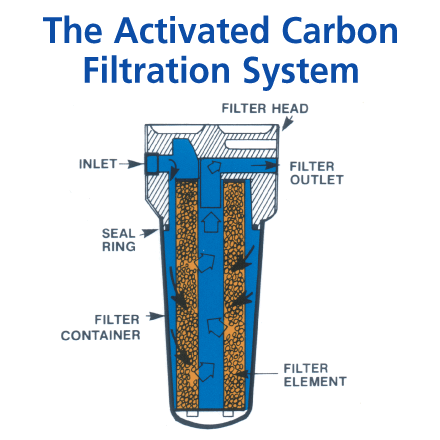Point-of-Use Activated Carbon Filtration
The importance of Clean, Clear Water
Water is such a basic part of our life that we often take it for granted. After all, water covers over 70% of the earth.
But did you know that a mere one percent of the earth’s water is available as freshwater supplies, either in groundwater, lakes, rivers and streams, or frozen in glaciers and polar ice caps. That precious fresh water may contain natural or manmade pollutants, or simply have an unpleasant taste or odor.
That’s why more and more people are turning to pointof- use (POU) water quality improvement systems to solve many of their water problems. These systems give the consumers control over the amount of water to be improved, the level of improvement, and the uses for the improved water.
How Activated Carbon Filtration Works
An effective method of improving water quality at the point-of-use is through activated carbon filtration. Long considered a “proven technique” for reducing soluble organic contaminants, an activated carbon filter can reduce organics and solid particles, as well as offensive tastes and odors from water.
Because of its molecular make up, activated carbon can absorb well That means it can take in or collect many organic molecules on its surface.
Questions and Answers about Point-of-Use Distillation Systems
Q: Specifically, what types of pollutants does activated carbon trap?
A: Activated carbon filters effectively reduce a wide range of organic materials, such as those listed in this brochure, as well as certain pesticides and fungicides. In addition, it reduces disagreeable tastes and odors, such as chlorine, from treated water.
Q: Will my water have a “charcoal” taste if filtered by activated carbon?
A: No. Your water should have a fresh, clean taste. In fact, many people claim that using filtered water enhances the aroma and flavor of coffee, tea, juices, soups, and other drinks.
Q: What about expense?
A: With a point-of-use activated carbon filter, consumers can improve the quality of their drinking and cooking water for just pennies per gallon depending on the size of the unit.
Q: What types of point-of-use activated carbon filters are available?
A: There is a range of sizes of point-of-use activated carbon filters; faucet mounted under-the-sink filters, and wholehouse filters. The most common, but smallest, is the faucet-attached point-of-use filter. Quick and easy to install, this filter is either attached directly to the faucet outlet or placed on the counter and attached to the outlet via a hose. Some faucet attached filters have a lever that routes water into the filter only on demand, thus prolonging the life of the filter.
A stationary activated carbon system can be installed under the sink. Before you buy this kind of system, measure the space under your sink to ensure a proper fit. Under-sink filters come in two types – those that filter all the water going through your faucet and those attached to the cold water line and a separate spout, thus using the filter only when desired.
Whole-house units filter all water entering the house. This can be important when treating for contaminants which can be absorbed during bathing or showering, or from inhalation. Talk to your Certified Water Specialist to determine which system is best for you.
Q: Will activated carbon filtration remove all contaminants from my water?
A: The level of contaminant reduction for activated carbon filtration will vary. Reductions depend on conditions such as the degree of contamination, the size and type of equipment, and product maintenance. No system can be warranted for a total elimination of all contaminants in all conditions. Consult your local WQA professional or the manufacturer for additional information.
Q: What about the maintenance of the unit?
A: For the activated carbon filter to be effective, most require maintenance involving periodic replacement of cartridges. Maintenance is critical to a well-functioning system. Cartridges can generally be replaced by the homeowner or a maintenance agreement can be reached with the local dealer. The life of the cartridge depends on the amount of water passing through the filter, the amount of impurities or contaminants present in the water, and the size of the filter. Consult the manufacturer’s guidelines or your local professional if you have any questions.

Reduces:
- Unpleasant Tastes
- Unpleasant Odors
- Trihalomethanes (THMs)
- Certain Volatile Organic Contaminants
- Certain Pesticides and Fungicides
Information
Consumer Tips
If you are considering the purchase or rental of point-of-use (POU) water quality improvement equipment, here are a few consumer tips from the Water Quality Association (WQA):
- If you suspect you have a problem with your water, have it tested to confirm the nature and extent of the problem. For aesthetic problems like hardness, your water can be analyzed in your home by a professional such as a WQA Certified Water Specialist (CWS); for health concerns, consult a state certified or other reputable laboratory.
- Research the water quality improvement products available before you buy. Check performance capabilities, warranty, maintenance provisions, and general operation. Be an educated consumer.
- Price is an important factor, but don’t let it be your only criteria. Capacity, special features or company services may make a more expensive product a more appropriate choice.
- All products require maintenance. Some technologies also require periodic component replacement. Determine whether you or the dealer will perform these functions.
- Look for the WQA Gold Seal on the POU equipment. It indicates the product met industry standards by sample testing.
- Research the reputation and legitimacy of the company or sales representative you choose. You may want to check customer references before you sign a contract.
- Multiple water quality problems may require multiple product solutions, a “systems” approach which combines several technologies in one system.
- Some in-home water tests can look spectacular, but the findings have little significance. Ask what’s being determined by a test and what it means to you.
- Deal with a professional, such as a WQA certified professional. Check your telephone directory or write WQA.
- Look for a company that supports the POU Industry Voluntary Product Promotion Guidelines and Professional Standards as published by WQA.



